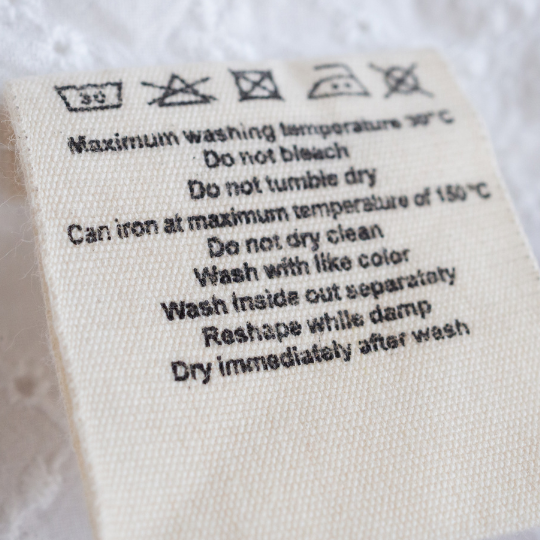20th Feb 2024
Scrub-tastic: How to Keep Your Medical Scrubs Spotless
Scrub-tastic: Stain Removal Guide
Stains on our scrub uniforms can be annoyingly stubborn, but they don't need to be a permanent fixture . You've just gotta know the tricks.
So, let's demystify removing stains from your nursing uniforms scrubs and medical clothing.
Read the Care Label First
|
Before you begin treating a stain, read the fabric care label in your scrubs. Understand what type of fabric you are dealing with and how it should be laundered.
Here are the most popular fabric blends for medical uniforms:
|
|
|
|
While some viruses and fungi can perish within a few days, others such as E. coli and salmonella, known for causing diarrhea, can endure for several weeks. Staphylococcus aureus, a bacterium responsible for skin infections, can persist for up to a month. If clothing remains damp, such as sweat-soaked work clothes, germs can proliferate in your laundry basket. |
| JUMP TO THE SOLUTION | BLOOD STAINS | VOMIT STAINS | FAECAL STAINS | SWEAT STAINS | IODINE STAINS | BALL POINT PEN STAINS | ALCOHOL-BASED MEDICATION STAINS | OIL-BASED MEDICATION STAINS |
BLOOD STAINS
|
Blood stains are at the top of our list because they are the most common. They are difficult to remove, but with the right techniques, they can be effectively removed.
|
VOMIT, FAECAL STAINS AND SMELLS
|
This pair is notorious for being challenging to remove. Vomit stains often contain a combination of substances including food, saliva, and stomach acid. And faecal stains, well, let's just say it's after everything goes through the stomach. But both stains can be treated the same way.
1. Blot the Stain: Use a clean dry cloth to blot the stain, removing as much of the vomit or faecal matter as possible. Do not rub the stain, as this will only spread it and make it more difficult to remove. 2. Rinse with Cold Water: Rinse the affected area of the scrub uniform under cold running water. You're diluting the stain and preventing it from setting into the fabric. 3. Apply a Solution: Mix a solution of one part white vinegar to two parts water. Apply this solution directly to the stain and let it sit for five minutes. 4. Rub with Detergent: Rub a small amount of liquid laundry detergent into the stain. Make sure to cover the entire affected area. 5. Soak: Soak the scrub in a solution of cold water and liquid laundry detergent for at least 30 minutes. 6. Wash: Wash the scrub in cold water on a delicate cycle. Use a stain-fighting laundry detergent, if possible. Avoid using hot water, as it can set the stain. 7. Check Before Drying: Before drying the scrub, check to see if the stain has been completely removed. If the stain is still present, repeat the process from step 2. |
SWEAT STAINS
|
Sweat and deodorant stains can be a common issue with medical scrubs, especially during long shifts. These stains are unsightly and can make your scrubs look worn and unhygienic.
Just remember to act quickly and to use the right products and techniques to get the best results. Working on them when they are still damp is best. 1. Blot the Stain: Use a dry cloth to blot the stain, removing as much of the sweat and deodorant as possible. Do not rub the stain, as this will only spread it and make it more difficult to remove. 2. Apply a Solution: Mix a solution of one part white vinegar to one part water. Apply this solution directly to the stain and let it sit for five minutes. 3. Rub with Detergent: Rub a small amount of liquid laundry detergent into the stain. Make sure to cover the entire affected area. 4. Soak: Soak the scrub uniform in a solution of cold water and liquid laundry detergent for at least 30 minutes. 5. Wash: Wash the scrub in cold water on a delicate cycle, use a stain-fighting laundry detergent if possible. Avoid using hot water, as it can set the stain. 6. Check Before Drying: Before drying the scrub, check to see if the stain has been completely removed. If the stain is still present, repeat the process from step 2. |
IODINE STAINS
|
Iodine stains can be stubborn and may require multiple attempts to remove. However, by following these steps and using the right products, you can effectively remove the stain and keep your medical scrubs looking fresh and clean.
1. Blot the stain: As soon as you notice the iodine stain, use a dry clean cloth or paper towel to blot the stain and remove as much of the excess iodine as possible. 2. Pre-treat with a laundry stain remover: Apply a laundry stain remover or a solution of equal parts water and white vinegar to the stain and allow it to sit for 5-10 minutes. This will help break down the iodine and make it easier to remove. 3. Wash in hot water: Wash the garment in hot water, using a laundry detergent that contains enzymes. The heat will help break down the iodine and the enzymes will help lift the stain. 4. Check for any remaining stains: If the stain is still visible after washing, repeat the pre-treating and washing process until the stain is fully removed. 5. Air dry or machine dry: Avoid using high heat in the dryer, as this can set the stain and make it harder to remove. Instead, air dry or use the low heat setting in the dryer. |
BALL POINT PEN STAINS
|
There is nothing worse than finding an ink pen has leaked inside your pocket, and now you have a big target of a stain soaking through your scrubs. Here's what to do:
1. Blot the Stain: Use a clean, dry white cloth to blot the stain, removing as much of the ink as possible. Do not rub the stain, as this will only spread it and make it more difficult to remove. 2. Apply a Solution: Mix a solution of one part rubbing alcohol to one part water. Apply this solution directly to the stain and let it sit for five minutes. 3. Rub with Detergent: Rub a small amount of liquid laundry detergent into the stain. Make sure to cover the entire affected area. 4. Soak: Soak the scrub in a solution of cold water and liquid laundry detergent for at least 30 minutes. 5. Wash: Wash the scrub in cold water on a delicate cycle. Use a stain-fighting laundry detergent, if possible. Avoid using hot water, as it can set the stain. 6. Check Before Drying: Before drying the scrub, check to see if the stain has been completely removed. If the stain is still present, repeat the process from step 2. |
ALCOHOL-BASED MEDICATION STAINS
|
Alcohol-based medication stains need to be dealt with straight away if you want a result, as they can be difficult to remove. Here's what to do:
1. Blot the Stain: Use a clean, white cloth to blot the stain, removing as much of the medication as possible. Do not rub the stain, as this will only spread it and make it more difficult to remove. 2. Apply a Solution: Mix a solution of one part white vinegar to one part water. Apply this solution directly to the stain and let it sit for five minutes. 3. Rub with Detergent: Rub a small amount of liquid laundry detergent into the stain. Make sure to cover the entire affected area. 4. Soak: Soak the scrub in a solution of cold water and liquid laundry detergent for at least 30 minutes. 5. Wash: Wash the scrub in cold water on a delicate cycle. Use a stain-fighting laundry detergent, if possible. Avoid using hot water, as it can set the stain. 6. Check Before Drying: Before drying the scrub, check to see if the stain has been completely removed. If the stain is still present, repeat the process from step 2. |
OIL-BASED MEDICATION STAINS
|
Oil-based medication stains will most likely take several attempts to remove due to the oily residue they leave behind. However, it is possible to get rid of these stains effectively. Here's what you need to do:
1. Blot the stain immediately: As soon as you notice the oil-based medication stain, use a clean dry cloth or paper towel to blot the stain and remove as much of the excess oil as possible. 2. Pre-treat with a degreaser: Apply a degreaser or a laundry stain remover to the stain and allow it to sit for 5-10 minutes. This will help break down the oil and make it easier to remove. 3. Wash in hot water: Wash the garment in hot water, using a laundry detergent that contains enzymes. The heat will help break down the oil and the enzymes will help lift the stain. 4. Check for any remaining stain: If the stain is still visible after washing, repeat the pre-treating and washing process until the stain is fully removed. 5. Air dry or machine dry: Avoid using high heat in the dryer, as this can set the stain and make it harder to remove. Instead, air dry or use the low heat setting in the dryer. |
FAQ FOR REMOVING STAINS FROM CLOTHING
|
Why can vinegar help remove stains?
Vinegar is a natural stain remover and can help break down and lift stains. The acidic properties of vinegar can help dissolve and remove dirt and other organic matter that may cause stains. Why is it important not to mix bleach and vinegar? DANGER! Mixing bleach and vinegar can create toxic chlorine gas, which can be harmful to breathe in. To avoid this, it is important to only use one or the other when cleaning or treating stains. What are stain-removal laundry detergents that include enzymes? Enzyme-based laundry detergents are specifically designed to remove stains. They contain enzymes that break down the stain-causing substances, making it easier to remove. These types of detergents are commonly available in your local supermarket. Why is rubbing alcohol effective for removing ballpoint pen ink stains? Rubbing alcohol is an effective solvent that can dissolve and remove ballpoint pen ink. It works by breaking down the ink and lifting it from the fabric fibers. What type of vinegar should I use for removing stains? White vinegar is the most commonly used type of vinegar for removing stains. It is a clear, mild-acidic solution that is safe for most fabrics and does not leave any residue. What is a degreaser? A degreaser is a cleaning product that is specifically designed to remove grease and oil-based stains. In New Zealand, popular degreaser brands include Muck-Off and Simple Green. In North America, popular brands include WD-40 and Goof Off. Why shouldn't I use high heat in the dryer when treating stains? High heat can set the stain and make it harder to remove. To avoid this, it is recommended to air dry or use the low heat setting in the dryer when treating stains. Disclaimer: Treating stains can be a complex process that depends on various factors such as the type of fabric and fibers, the manufacturer's recommendations, and the composition of the stain. The information provided in this blog is intended as a guide and may not be suitable for all stains and fabrics. It is always recommended to follow the manufacturer's instructions and test any cleaning or stain-removal methods on a small, inconspicuous area of the garment first. |









